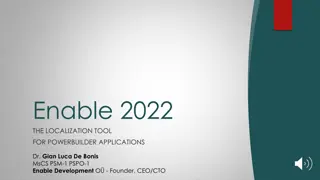
Scientific Writing Principles and Research Paper Structure
Explore the fundamental principles of scientific writing, emphasizing clarity, correctness, and completeness. Understand the structure of a scientific research paper, from introduction to conclusion, highlighting the significance of titles and abstracts in attracting and informing readers effectively.
Uploaded on | 1 Views
Download Presentation

Please find below an Image/Link to download the presentation.
The content on the website is provided AS IS for your information and personal use only. It may not be sold, licensed, or shared on other websites without obtaining consent from the author. If you encounter any issues during the download, it is possible that the publisher has removed the file from their server.
You are allowed to download the files provided on this website for personal or commercial use, subject to the condition that they are used lawfully. All files are the property of their respective owners.
The content on the website is provided AS IS for your information and personal use only. It may not be sold, licensed, or shared on other websites without obtaining consent from the author.
E N D
Presentation Transcript
Research Project I MUSTANSIRIYAH UNIVERSITY COLLEGE OF SCIENCES DEPARTMENT OF ATMOSPHERIC SCIENCES 2022-2023 Dr. Sama Khalid Mohammed FOURTH STAGE LECTURE 8
Basic principles in scientific writing All scientific writing should follow the 7 C s-rule, i.e. scientific writing should be: 1. Clear: Unmistakable, not leading to confusion 2. Correct: Accurate, free from error (Not prone to interpretation and speculation ). 3. Complete: Contain all necessary parts and information to be clearly understood 4. Concise : to the point, devoid of redundant information and words. 5. Conform to the requirements set by the university and to the standard conventions and basic principles in: a. Style: units, rules of abbreviations , literature citations etc. b. Format: shape, size, general make-up of a publication 6. Consistent : uniform throughout the text in spelling, structure, style, format, layout, typography, etc. 7. Common sense prevails!
Structure of your Scientific Research A research paper organized into several sections: First the author states the purpose of the investigation, placing the work in a broader scientific context (Introduction). Then the procedure is described (Materials and Methods). Afterwards, the findings are presented (Results), interpreted (Discussion) and summarized (Conclusion). Title and abstract Both the title and the abstract are very important parts, since these will be read most often by many readers. They serve two purposes for your readers: 1. to disclose the basic information of your research 2. to help readers decide whether or not to read the entire paper.
Structure of your Scientific Research Title: should attract attention, but most important, it should be informative and concise. A good title indicates the main point of your study, so use: The most precise words possible. Words that lend themselves to indexing the subject (your title is the first source for key words for indexing services). On the other hand, be sure your title will make sense to someone not familiar with your subject. Provide adequate information, but don t make your title too long: 8-12 words is a good range.
Structure of your Scientific Research Abstract: gives the reader a clear idea of the subject studied, it helps to decide whether or not to read the full thesis/paper and it provides words for indexing. The abstract is a concise (max. 1 page, condensation of the content of the full report by 95%), complete report of your work that can stand alone without further explanation. It should include: The objectives/hypothesis of the study and justification for conducting the investigation (What?, When?, Why?) The basic materials and methods used (How?) The main results obtained and significant conclusions that can be drawn. The abstract should not include: A discussion of your results References Tabulated data Any abbreviations, unless they are understood when standing alone (e.g. DNA , pH , USA ).
Structure of your Scientific Research Introduction =WHAT? The introduction places the work you have done in a broad theoretical context and provides the reader with enough information to appreciate and understand the relevance your objectives. The introduction should be informative explain the reason for the study and your major objectives clearly identify the subject of your research state the hypothesis you are investigating or define the problem you are trying to solve bring the reader up-to-date on what has already been done provide background information on the research subject give a concise literature review (unless you have a separate literature review section) to orient the reader by summarizing pertinent literature in your field be written in the present tense
Structure of your Scientific Research Literature review Typically, using the simple past tense is common, e.g., "Jones (2013) found that...." But it is possible to use more than one tense in a literature review. Here are a few tips to consider when presenting a review of previously published work: Past tense: If your focus is on the study itself or the people who studied it, then it is better to use the past tense. In this case, the study would be the subject of your sentence, "e.g., Jones (2013) reported that..." The past tense is most commonly used and is also known as "the reporting tense." Present tense: If you are sharing your own views about a previous study, it might be better to use the present tense, e.g., "Jones (2013) argues." Present perfect tense: Sometimes, the present perfect tense is used if the research you are referring to is fairly recent, e.g., "Recent studies have demonstrated that...(Jones, 2015; Pinto 2014)". It is also used to make generalizations about past research in an area, e.g., "Several researchers have studied these stimuli.... You can check the paper in the link
Structure of your Scientific Research Materials and methods = WHERE and HOW? Your methodology creates the context for evaluating your data. How you took your samples and did your measurements, what controls you used, what variables you did and did not consider, which assumptions you made; all these things play an important role in the interpretation of the results. This section should: provide information such that your study can be duplicated/repeated by others describe procedures and methods used, e.g. sampling strategy/frequency/location/date, experimental design, tools and sampling devices used, manipulation of the samples, statistical analysis, complete taxonomic information of the organisms used, data quality assurance etc. where appropriate, use flowcharts to visualize the processing methods and handling of your materials be organized logically and orderly be written in the past tense
Structure of your Scientific Research Notes: If you used a well-known method, name it and refer to the paper in which it is described. If you modified the well-known method, describe how and why you modified it. Results =WHAT DID YOU FIND? This is the most important part! The Results section should summarize the data, emphasizing important patterns or trends, and illustrate and support your generalizations with explanatory details, statistics, examples of representative or atypical cases and references to tables and figures. Use the past tense.
Structure of your Scientific Research Do: Present your results in a logical and orderly fashion and use the same sequence as in the Materials and Methods section Be complete, but concise Make maximal use of tables and figures (see section 4). One good graph can be worth a 1000 words! Give final and meaningful data only (no raw data), e.g. after statistical processing Do NOT: Give the same results twice or more, e.g. in the text, a table and a graph, but chose the most appropriate way for presentation Omit data that you consider negative (in the sense that they don t comply to your hypothesis) Give primary (raw, unprocessed) data Interpret the data or draw major conclusions; this should be done in the Discussion and Conclusion sections, respectively
Structure of your Scientific Research Discussion =WHAT DO ALL THESE RESULTS MEAN? The Discussion section should Relate your results to your hypothesis: do your results prove that your hypothesis is correct or not, and how/why? Interpret the results with emphasis on the problem, question or hypothesis you put forward in the introduction Relate the data to their causes: i.e. why the data are what they are Relate your findings to those obtained by other researchers: whether they corroborate your results or whether they don t and support this with evidence Be careful with extrapolating your results too broadly: avoid speculation and generalization.
Structure of your Scientific Research Conclusions What conclusions can you draw from your findings (these can be enumerated)? What is their significance with regard to the problem you tried to solve? State briefly any implications for practical applications or future studies if appropriate Eventually recommendations (if appropriate) Many scientific journals do not publish a separate Conclusions section, instead, Discussion and Conclusions are combined, but for a thesis, keep them separated.
Structure of your Scientific Research Acknowledgements Briefly (max 1 -1.5 pages) thank people who helped you professionally, namely with: Sampling Reviewing your manuscript Statistical analysis Lab work (technicians) Providing access to specific equipment or facilities, not available in your laboratory Funding your research: mention the source of funding (e.g. This research was financed by a student grant from the National Science Foundation) . If your work was part of a larger project, mention it as well as the financing or sponsoring authority Only mention people who really contributed to your work. For the thesis specifically, you should express your gratitude towards the people who guided you (promoter, copromoter) and if you want, you can express your appreciation for the support of your family and friends.






















